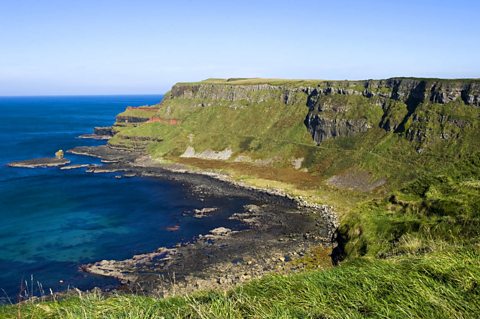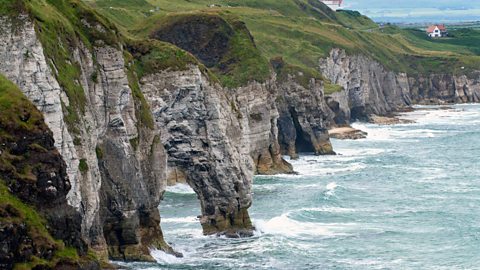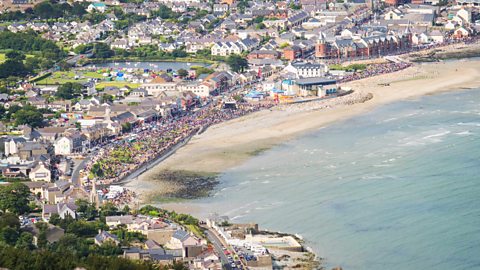Northern Ireland's Coast

Northern Ireland is fortunate to have some amazing examples of different coastlines that are often enjoyed by the people who live here and by those that choose to come and visit.

Waves
- Waves are formed as the wind blows across the surface of the sea.
- When waves reach the coast, they break and water and any sand it carries runs onto the shore - this is the swash. Then the water runs back to the sea – this is the backwash.
- There are two different types of waves that are at work on Northern Irish beaches – Constructive and Destructive waves.
- In constructive waves, the swash is more powerful than the backwash so they add material, such as sand to the shore.
- In destructive waves the backwash is more powerful than the swash and material may be carried off the shore back to the sea.
Destructive waves
- Destructive waves have more energy and often cause coastal erosion.
- Destructive waves are steep and arrive at the coast rapidly (between 12-15 per minute).
- Their strong backwash will pull beach material back into the sea.
Coastal erosion
The sea shapes the coastal landscape. Coastal erosion is the wearing away and breaking up of rock along the coast. Destructive waves erode the coastline in a number of ways:
- Hydraulic action: Air may become trapped in joints and cracks on a cliff face. When a wave breaks, the trapped air is compressed which weakens the cliff and causes erosion.
- Abrasion: Bits of rock and sand carried by the wave grind down cliff surfaces like sandpaper.
- Attrition: Waves smash rocks and pebbles on the shore as they break up they become smaller, smoother and more rounded.
- Solution: Slightly acidic sea water can dissolve some types of rock such as chalk and limestone.

Constructive waves
- Constructive waves are less steep and break less frequently (6-10 per minute).
- Their strong swash can add material onto the shore.
Deposition
Deposition happens when the swash is stronger than the backwash and is associated with constructive waves.
Deposition is likely to occur when
- waves enter an area of shallow water
- waves enter a sheltered area, such as a bay.
- there are light winds.
- there is a good supply of sediment from offshore.

Coastal features – beaches and cliffs
Along the Northern Ireland coast you will be able to see a variety of landforms that have been created due to the constructive or destructive waves. Deposition by constructive waves forms sand or shingle (pebble) beaches and spits. Erosion by destructive waves forms headlands with cliffs and caves.
The erosion of a headland
Hard rocks that form headlands, land that juts out into the sea, are eroded by powerful waves. Cliffs are formed and waves attack any weaknesses in the rocks. Cracks are formed which, over time can widen into caves, arches and stacks.
- Waves erode cracks in the rocks of the headland.
- These cracks are widened by hydraulic action and abrasion to form caves at the base of the cliffs.
- Erosion continues and the caves grow larger and deeper. They may break right through the headland to form an arch.
- Erosion by the weather and waves will eventually weaken the roof of the arch and cause it to collapse leaving behind a tall column of rock, called a stack.
- The stack will be attacked at the base in the same way that a wave-cut notch is formed. This weakens the structure and it will eventually collapse to form a stump.
Coastal management
Land at the coast is valuable – it is a popular place to live (residential) but it is also used for tourism, fishing, industry, trade and transport. This means that sometimes decisions have to be taken to protect the coastline.
There are two types of engineering that can be used to help protect coastlines:
Hard engineering involves building structures, such as sea walls to stop erosion and flooding of the coastline.
Soft engineering involves using more environmentally friendly and ecologically sensitive methods to manage erosion and flooding. One example is adding sand to existing beaches, this is called beach nourishment.
Coastal management in Newcastle, Co Down
The tourist resort of Newcastle, Co Down has long been under attack from the sea that has regularly caused flooding along the main street.

A number of measures have been used to manage the coastline over the last 100 years:
Sea walls
In 2007 a new Newcastle promenade (coastal walkway) was built which included a brand new sea wall that was raised more than 2 metres above the beach. The sea wall face was curved so that the energy of breaking waves is reflected out into the sea.
Gabions
Gabions are large, open wire boxes filled with rocks. These are built together where erosion is a risk. As waves crash onto them the wave energy is dispersed and coastal erosion reduced. A series of gabions have been installed to protect the beach at the Slieve Donard Hotel and to stop the erosion of the sand dunes at the Royal County Down Golf Course.
Groynes
Groynes have been used to try and trap sand at the coast in Newcastle for nearly 80 years. They are usually made out of wooden posts and planks that are built like a fence across the beach. The idea is that as the sea comes in, the fences will trap sand and stop it from being moved further along the beach.
While Groynes and Gabions are cheaper to install than Sea walls, they need maintenance and must be replaced regularly.
How could climate change impact our coastal areas?
- If sea levels start to rise, we will start to notice the impact immediately.
- Recent storms across Northern Ireland have shown that tides have been high which means that there is a much bigger chance of flooding.
- Even places that have sea walls and barriers in place could experience a greater number of floods. These will disrupt transport and damage homes and businesses.
- Currently many of the beaches and sand dunes along Northern Ireland’s coast are losing sand due to increased erosion by the sea.
Watch: Newcastle's coastal management
Max Heartrate focuses on Newcastle's coastal management.
DIRECTOR: Standby on the floor.
DIRECTOR: Coming to you camera two.
DIRECTOR: Cue on two.
DIRECTOR: Mix-through.
MAX: No time for that! Hello! I’m Max Heartrate and this is Knowledge Express. Information faster than a mink on a motorboat. And today’s topic is…
MAX: Coastal Weather in NI
MAX: Northern Ireland is a relatively small country, but did you know it has over 600 kilometres of coastline most of which is absolutely stunning! Cliffs, headlands, caves, sandy beaches, shingle beaches and rocky shores – something, as they say, for everyone! And how did it get to be so amazingly varied? One word – the sea!
MAX: Well, that’s two words technically but you get what I mean.
MAX: Yes, waves of water constantly altering the land they come up against.
MAX: Sometimes they deposit material on the shore (constructive waves), sometimes they take stuff away (destructive waves). Over thousands of years the sea has shaped our shores.
MAX: Now, this is all good up to a point. But the coast isn’t just about beautiful landscape, it’s also about fishing, industry, trade, transport and houses. These things often need protected from the sea. We call this coastal management.
MAX: Take Newcastle for example. You wouldn’t be able to head down on a sunny Bank Holiday unless someone was looking after the shoreline properly. Newcastle has been under attack from the sea for years, so the council has to defend it. Otherwise… FLOODS AHOY!
MAX: So, a new sea wall was built in 2007, raised more than 2 metres above the beach. Gabions - big metal boxes full of rock that prevent erosion, are put on the shore to protect the sand dunes. And groynes - wooden structures like a fence – are built on the beach to stop the waves taking the sand away.
MAX: And with the dangers of sea levels rising due to climate change the challenges to Newcastle will keep coming. All that effort so you can have a 99, a bag of chips and a go on the dodgems! Eh? Stickin’ out!
Activity: Quiz - Take the coast test
More on Coastal Landscapes
Find out more by working through a topic
- count2 of 2
